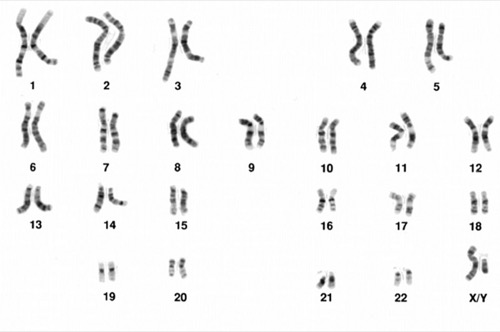You are here: Urology Textbook > Urologic examinations > Karyotyping
Karyotyping: Human Karyotype Analysis
Karyotyping is the microscopic analysis of all chromosomes of a cell by size, centromeric location and band pattern.
Indications:
Karyotyping is indicated as a screening test for chromosome aberrations in case of severe disorders of sex develop, proximal hypospadias, Turner syndrome, Down syndrome, Klinefelter syndrome, recurrent abortions, and oligozoospermia.
Laboratory test method
Microscopic analysis of the chromosome set of a cell in the metaphase, in the state of maximum DNA compression. The chromosomes are numbered and evaluated according to size. The different staining of the chromosomes is caused by the euchromatin and heterochromatin and leads to a characteristic band pattern. This allows the identification of individual chromosomes, possible numerical chromosome aberrations or deletions and translocations [fig. normal human karyotype].
Further cytogenetic examination methods:
The classical banding technique can reliably detect gross changes in the chromosome structure, but very small chromosomal aberrations (microdeletions or translocations) are not detected. Modern cytogenetic examination methods such as fluorescence-in-situ-hybridization (FISH-analysis) and comparative genomic hybridization using array-comparative genomic hybridization (Array-CGH, molecular karyotyping) allow high-resolution studies of the entire genome for chromosomal aberrations.
 |
| Genetic testing | Index | Semen analysis |
Index: 1–9 A B C D E F G H I J K L M N O P Q R S T U V W X Y Z
References
 Deutsche Version: Karyogramm
Deutsche Version: Karyogramm